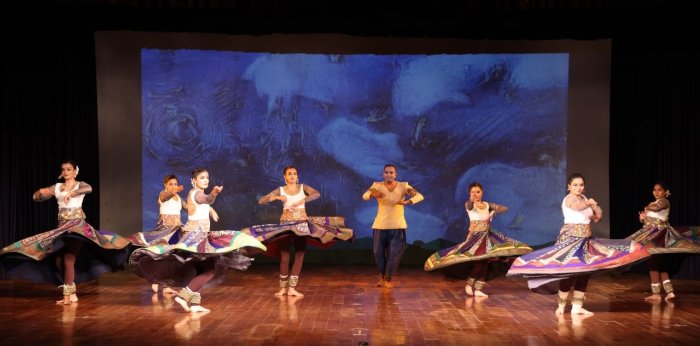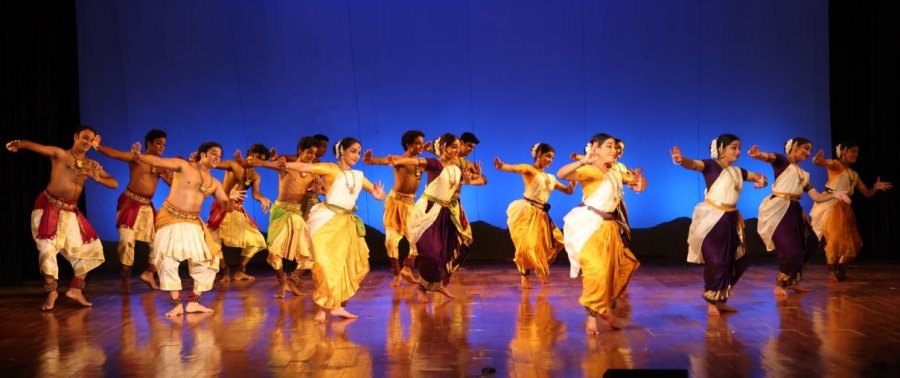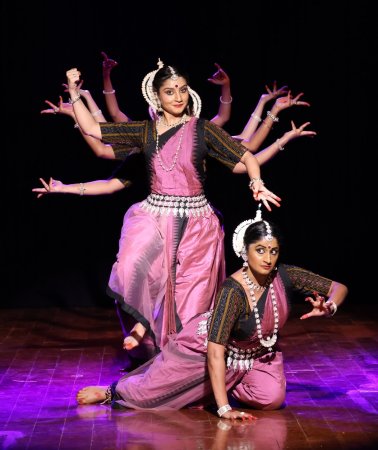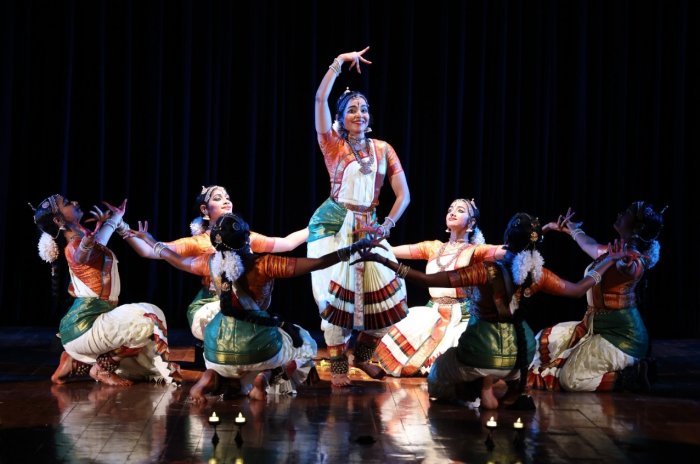
|   |

|   |
 e-mail: leelakaverivenkat@gmail.com The searchlight on art of critiquing in Amrit Yuva Kalotsav by SNA December 26, 2022 The Late Subbudu (P.V. Subramaniam), a music and dance critic whose caustic pen scorched many an art reputation without compunctions, and who seemed to thrive on unpopularity, often quipped that more than art, criticism was in peril, in a world where journalistic space for critiquing was getting to be minimal, with artistes who had 'arrived' so to speak, not open to accepting less than flattering comments about their work. In India, where no formal degrees specify credentials for art critiquing, dance and music critics form a mixed group - some coming from learned backgrounds and others acquiring knowledge on the run. Along with writing skills, art critiquing needs to be driven by a passion for the art form, since the very modest remuneration critiquing fetches in our country, has meant its being pursued more as a labour of love, rather than as the main occupation of a person earning his living. Where, society in its total scheme of things places art and its assessment, will finally determine the level of proficiency in art critiquing. Sangeet Natak Akademi's Amrit Yuva Kalotsav 2022-23, in collaboration with Kalakshetra Foundation, initiated its two day event at Chennai, with the searchlight on an Art Critiquing workshop for aspiring youngsters, held at Kalakshetra's Rukmini Arangam. With Sruti Editor S. Janaki as moderator, panellists comprising well known Bharatanatyam artiste and author of books Lakshmi Viswanathan, critic Nandini Ramani, daughter of Sanskrit scholar Dr. Raghavan and Bharatanatyam trained under Balasaraswati, V. Kaladharan, expert on traditions from Kerala, music and dance critic Manjari Sinha and this writer, answered questions about our experiences. Nandini Ramani and Lakshmi Viswanathan spoke of their backgrounds in families steeped in scholarship and the arts, while for this critic, with the common experience of being reared in a family where being initiated into dance and music was part of growing up, much like schooling, it was a case of wandering from journalism into the critiquing arena, through a quirk of circumstances. Manjari Sinha in a Hindi / English blend, spoke of some subtle aspects of music, the critic needed to develop an ear for. I mentioned the case of late critic/journalist Shanta Serbjeet Singh, who became a dance writer due to fortuitous circumstances, (with no vacancy for any other specialised writing in the dailies) and acquired a name for looking at a performance from a larger global perspective without ever delving into, or being too concerned about the technical aspects of a specific dance form. Aspects like the need to be aware of the kind of readership one writes for: the language ease in being able to communicate technicalities without putting off the reader, with terms which mean little to him:; being to-the-point while critiquing; even-handed mention of both the praiseworthy aspects of a dance or music presentation along with its less flattering aspects; and the need for an objectivity, concentrating on the art rather than the artist persona, were all referred to. In the final analysis, critiquing is as much a learning experience as performing - for nobody knows everything. More than any other field, critiquing forces the realisation of how much there is still to know. And rather than the image of a censorious person making lofty judgements, evaluating and analysing art (which is what criticism is) imposes a responsibility which can weigh one down. Critiquing can take various forms - descriptive, analytical, interpretative or evaluative. There is no finality about how to assess a programme, for the writer's attitude to aspects like new ideas being tried out in traditional art forms with a prescribed performance format which has been followed for years, and one's response to seniors performing with bodies no longer able to fully carry out what the spirit wills, are all factors which will vary from critic to critic. And over time, the same critic may be persuaded to think differently on certain points. Ultimately, as in all professions, there is no formula or shortcut to good critiquing. The students exposed to the proceedings seemed to find the two day discussion enlightening. But in the final analysis, like the artiste, the critic too has to evolve and mature through constant exposure to the arts, developing a trained eye for dance, a sensitised ear for music and a language facility, adequately expressive. One has to go through the mill, taking the rough with the smooth, developing an objectivity free of preconceived notions. The need to keep informing oneself and keeping in touch with developments in each dance or music tradition is a must. In the final analysis, if the SNA, as passingly mentioned by the new Chairman Dr. Sandhya Purecha, (collaborating with a university if so needed) can formulate a scheme and blue print of a syllabus and course for dance writers, with a degree at the end, qualifying the concerned person's credentials for art critiquing, it would provide a boost to critiquing in arts, in the country. The evening programmes planned in Kalotsav featured different traditions from various parts of the country, underlining the culturally unified diversity of our land. Rather than a political unit named India determined by mechanistic, machine-led western colonisers, this programme underlined a civilizational entity with its binding spiritual consciousness and which, since eons, has been referred to as 'Bharat,'- 'Bharatavarshe' the area from Mount Kailash in the north to Kanyakumari in the South - mentioned in Sanskrit texts as ancient as the Markandeya Purana (dated 250 CE by scholars). As the chief guest, the Tamilnadu Governor R.N. Ravi, so succinctly mentioned in his inaugural speech, the boundaries of Bharat, bound by an intangible cultural consciousness, were not set by any conqueror - but defined by expressive intangibles, manifesting in our heritage of music, dance, story-telling, rituals, way of life, philosophy and what have you. This culture of inclusivity, the Governor said, quoting Gandhiji, had been buried under a colonising of the mind by British rule - slowly obliterating our inner deep-rooted sensibilities. After seventy five years of Independence, it was time for Bharat to shed the leftovers of the colonial mindset, to rediscover ourselves, regaining the cultural sensitivity and oneness binding our diversity. It was a fine gesture starting with sonorous Vedic chanting by R.Seetharama Dikshitar and group from Tamilnadu, of verses from Taitireeya Upanishad and the Sama Veda. But with ghanapadi experts who are trained to throw out their voices, one wishes that programme supervising officials would allow such recitations without loud speakers - which make what is soothing, sound raucous.  Dashabhuja Gotipua Odishi Nrutya Parishad Dashabhuja Gotipua Odishi Nrutya Parishad from Odisha, is one of those groups whose Gotipua presentation has not become far too sophisticated -robbing it of all the rustic charm. The group comprising boy twins and slightly older performers, after the starting Panchadeva Vandana, showcased a series of bandha nrutya poses, bodies contorting with the greatest of ease. Pity that the presentation avoided even minimal samples of its charmingly innocent mimetic presentation, based on old Oriya songs like Manasu mana...  Natya Institute of Kathak and Choreography Natya Institute of Kathak and Choreography from Bangalore presented Madhu Nataraj's group, in very neat, simple Kathak numbers, conceptualised round the spirit of nationalism and patriotism. A hint of the usual Kathak virtuosity was in the opening presentation built round Sat Bhavana philosophy from Brihadaranya Upanishad. The prayer Om asatoma sad gamaya - leading from ignorance of darkness to the light of knowledge, thoughts of freedom fighters like Gandhi, Sarojini Naidu, Tagore - all grist for the Kathak choreographic mill - right from the days of Madhu Nataraj's mother Maya Rao - a Kathak pioneer who belonged to the first batch of students selected to be trained at Sriram Bharatiya Kala Kendra under Guru Shambhu Maharaj. Part of Maya's creation Tarane-e-Hind was presented. Fired by the nationalistic fervour, its inaugural presentation being on August 16th in 2004, the work was based on Allama Mohammad Iqbal's poem Sare Jahan se Achha in ghazal style first published as a patriotic song for children in 1904, in the weekly Ittehad. Choreographic ideas for dance inspired by contemporary sensibilities have been inherited by daughter Madhu Nataraj- grappling with themes like the firing of a space craft, with Rakesh Sharma's voice speaking a few words in space, and having multimedia projections as a backdrop while the dancers are performing.  Kalakshetra ensemble Kalakshetra troupe presenting Bharati kanda Bhaaratam on Bharatam as envisioned by Bharatiyar in his songs, was in complete alignment with the idea of the Kalotsav. Needless to say the large group of male and female dancers performed in unblemished ensemble harmony, given the institution's years of practice with attention to detail. The finale of Choral Music, got cancelled due to the incessant rain and squall. The second evening began with Nangiarkoothu, presented by Margi Vishishta and group from Kerala. Margi, the Koodiyattam Centre was started by late Appukuttan Nair, the great scholar specialising in Kerala's classical traditions. Lately, this organisation, experiencing lean times, has not been in the news. As a very promising young trainee of SNA's special scheme for Nangiarkoothu, Margi's Vishishta, I later learnt, became the automatic choice for this Youth festival. She presented Narasimhavatharam, a narrative, not oft seen, as part of the traditional repertoire. In Koodiyattam, with the powerful rhythmic pulse provided by the mizhavu percussionists, the actor, in a leisurely fashion, develops the narrative from slow beginnings, building up pace and power, climaxing in an explosively fiery end. Surprisingly, except for the final bit when Narasimha emerges from the pillar to rescue his young devotee Prahalada, and tears into the entrails of Hiranyakashipu, it was a low voltage performance- despite the mizhavu copper drum percussionists, who did their best. One can only ascribe this to the time limit of less than half an hour insisted upon by the festival organisers - which constraint requiring constant vigil on the clock, came in the way of slowly elaborating and losing oneself in the performance. Rajasthan's Maand singers with their powerful voices and Khamaicha string instrument and Kartal and Dholak have always charmed audiences in all parts of the world. Here again, mikes and sound needed to be toned down so that decibel levels did not destroy the melody in the music of these singers from Jaisalmer and Barmer region with powerful vocal cords which can carry their music across the open desert areas. Starting with "Kesariya Baalam.." (which the troupe repeated for welcoming the Union Minister for Parliamentary Affairs and Culture, Arjun Ram Meghwal), Roshan Khan Manganiyar and group, as usual, enthused a riveted audience with their performance. Adding a hitherto not experienced chapter to the evening, was the Minister, who after his speech in a Hindi/English blend, with constant references to our greats, particularly Swami Vivekananda, in cross-legged seated position, settled down in the middle of the Manganiyars (who accompanied him) to render a Meera Bhajan! Here was a true example of the syncretic culture of India binding all classes of people! While Vasanta Raas by the Manipuri Dance Academy from Imphal, has been presented countless times and commented upon for its traditional, inevitable features of grace, costume aesthetics and highly involved vocal support, this critic, due to unavoidable reasons, missed out on the last two presentations - the first being Telengana's Lambadi dance, followed by the concluding item of Mayur Raas and Phoolon ki Holi, which, by all accounts the next morning, had the entire charmed audience participating with the group on the stage, to be drowned in a mound of flowers! 'The experience of a lifetime, to be treasured!' was the comment from all quarters, the next day. With the Governor's presence, the venue for last evening's presentation, impeccably planned and timed to perfection, was the main auditorium of Kalakshetra.  Nrityantar ensemble Nrityantar Academy of Performing Arts from Bengaluru began with an Odissi item on the Devi, conceived by founder Madhulita Mohapatra. Odisha being one of the shakti peethas of Devi, the Goddess is worshipped in several powerful manifestations - as Manikeswari worshipped particularly in Kalahandi's Parlakhemundi, Chamundeshwari, Durga, Mahishasuramardhini (Devi as Dasha Maha Vidhya is celebrated only in Odisha.) With music by Sukanta Kundu and rhythmic inputs by Dhaneswar Swain, Madhulita's choreography had six dancers perform with verve, in perfect group synchronicity the formations alternating between benign and destructive attitudes of the Devis. The second item, based on a Purandhara Dasa lyric in Kannada "Hari smarana madu", was interestingly set to a ragamalika in the Odissi music tradition by Bijay Kumar Jena, with rhythmic inputs by Bijay Kumar Barik. After one got used to some words being elongated or split (differently from the Kannada original) to suit the gait of Odissi music and dance, one enjoyed the episodic treatment portraying Vishnu/Krishna coming to the rescue of his devotees like Gajendra the elephant, young Prahalada and finally saving Draupadi.  Sridevi Nrithyalaya Immediately after Pooja Kunitha presented by Manvi Janapada Kala Samsthe from Karnataka, came a Bharatanatyam group Sridevi Nrithyalaya, Chennai. Sheela Unnikrishnan's choreography for Jayati Bharati, based on patriotic songs in ragas like Desh and Kamas, concentrated on group aesthetics, which was praiseworthy, rather than on an interpretative presentation with gestural translation of the words of the songs. Notwithstanding group dynamics in question, one wonders if the challenges of ensemble artistry can blend with the interpretative expertise of solo Bharatanatyam. After a crisp Tala Vadya Laya Sangam by Neyveli R. Narayanan and group from Tamil Nadu, came the finale with a powerful stage presentation of Aparadhini - Women without Men, by Theatre Nisha from Chennai. Based on Shivani Gaura Pant's story, this one act play, directed by Meera Sitaraman, in a moving naturalistic presentation, made a strong unabashed statement, on how our society has been guilty of having history repeat itself, in the treatment meted out to its women. Trying to find some degree of normalcy, even while incarcerated in jail for crimes like murder, robbery, even dacoity, committed under desperate circumstances, are a group of women of varying ages, unabashedly open in giving expression to details of their life. Beaten, abused and exploited as they are, society which is quick to bring them under the surveillance of law, seems blind when it comes to realising that one half of our society has little room to flourish, while struggling to find a degree of autonomy in life. Circumstances seem beyond their control. Interspersed with snatches of singing, enacted with a tremendous sense of involvement, this finale made one leave the hall, pondering over a social drawback which has been crying for healing. SNA follows up with similar festivals planned over different parts of the country.  Writing on the dance scene for the last forty years, Leela Venkataraman's incisive comments on performances of all dance forms, participation in dance discussions both in India and abroad, and as a regular contributor to Hindu Friday Review, journals like Sruti and Nartanam, makes her voice respected for its balanced critiquing. She is the author of several books like Indian Classical dance: Tradition in Transition, Classical Dance in India and Indian Classical dance: The Renaissance and Beyond. Post your comments Pl provide your name and email id along with your comment. All appropriate comments posted with name and email id in the blog will also be featured in the site. |